Influence of Culture, Politics, Power and Motivation on Behaviour
VerifiedAdded on 2023/06/18
|19
|5849
|458
Report
AI Summary
This report provides a comprehensive analysis of organisational behaviour, focusing on the influence of organisational culture, politics, and power on individual and team behaviour within Tesco, a British multinational retailer. It evaluates the impact of various cultural dimensions using Hofstede's theory and discusses the different types of organisational power and politics. Furthermore, the report examines content and process theories of motivation, such as Maslow's Hierarchy of Needs and Herzberg's Two-Factor Theory, to understand how motivational techniques can enable effective goal achievement. The analysis extends to team dynamics, discussing the characteristics of effective teams and the application of team development theories. Finally, it explores the concepts and philosophies of organisational behaviour, particularly the path-goal theory, and their influence on employee behaviour, providing a holistic view of organisational dynamics and offering recommendations for improving team and organisational success.
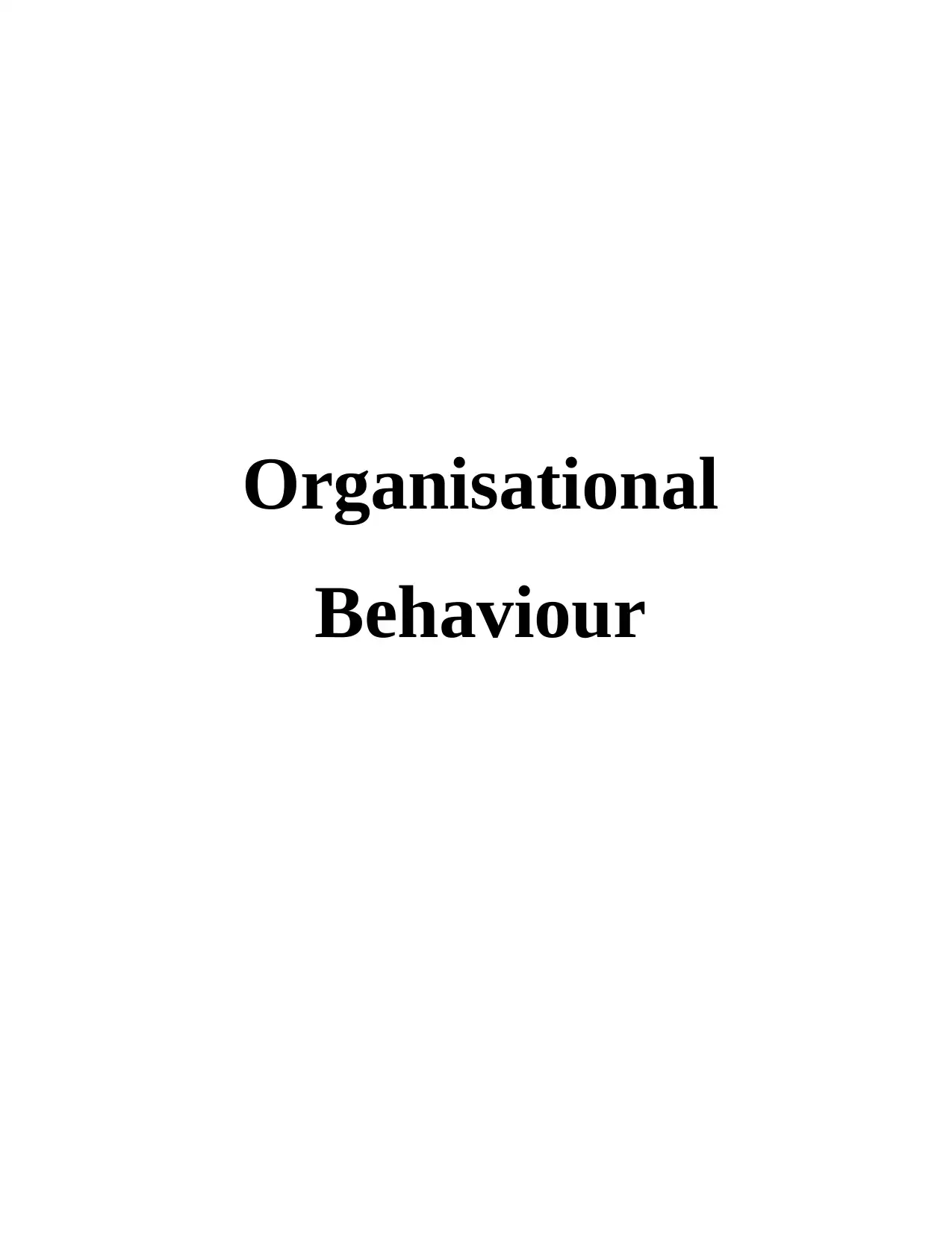
Organisational
Behaviour
Behaviour
Paraphrase This Document
Need a fresh take? Get an instant paraphrase of this document with our AI Paraphraser
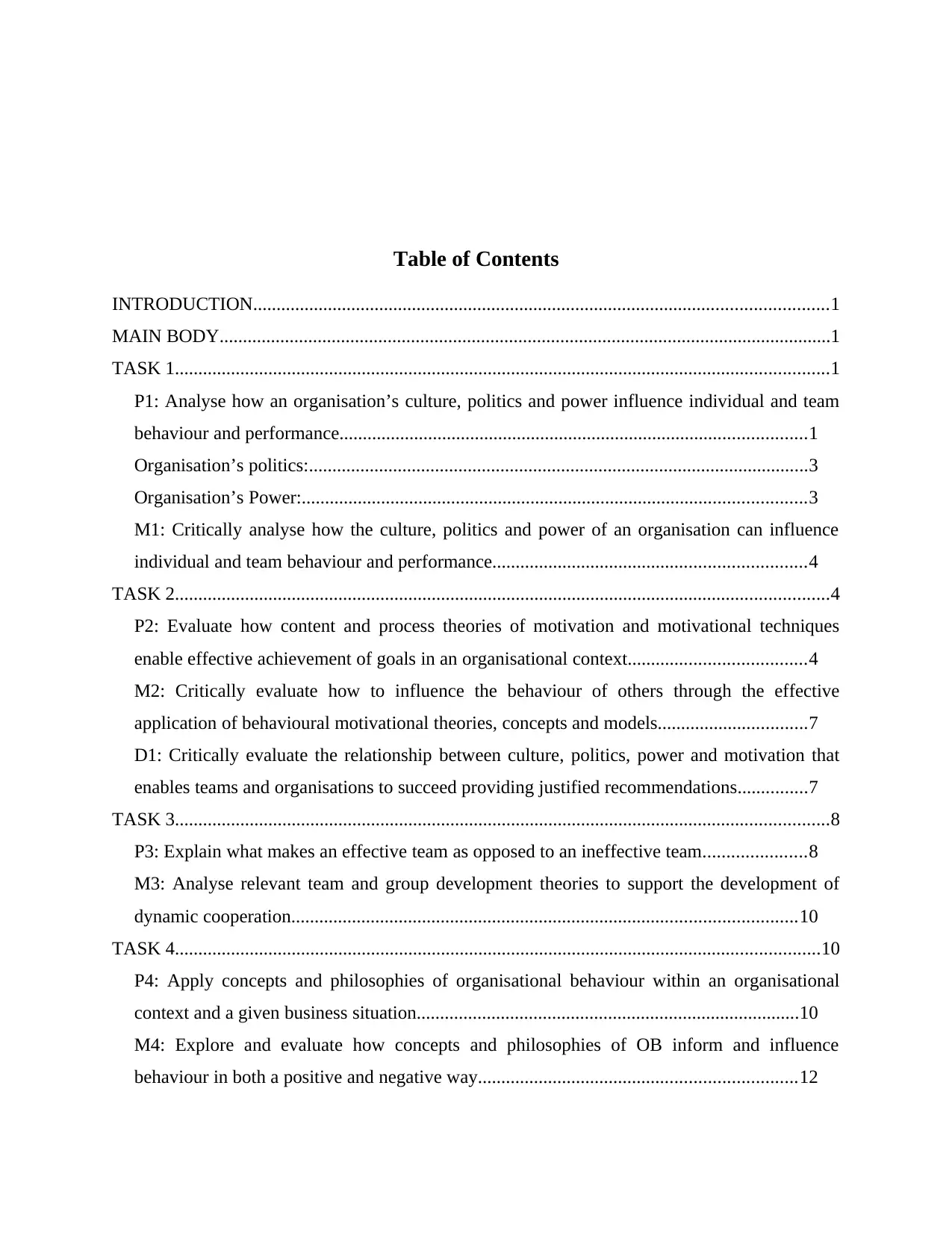
Table of Contents
INTRODUCTION...........................................................................................................................1
MAIN BODY...................................................................................................................................1
TASK 1............................................................................................................................................1
P1: Analyse how an organisation’s culture, politics and power influence individual and team
behaviour and performance....................................................................................................1
Organisation’s politics:...........................................................................................................3
Organisation’s Power:............................................................................................................3
M1: Critically analyse how the culture, politics and power of an organisation can influence
individual and team behaviour and performance...................................................................4
TASK 2............................................................................................................................................4
P2: Evaluate how content and process theories of motivation and motivational techniques
enable effective achievement of goals in an organisational context......................................4
M2: Critically evaluate how to influence the behaviour of others through the effective
application of behavioural motivational theories, concepts and models................................7
D1: Critically evaluate the relationship between culture, politics, power and motivation that
enables teams and organisations to succeed providing justified recommendations...............7
TASK 3............................................................................................................................................8
P3: Explain what makes an effective team as opposed to an ineffective team......................8
M3: Analyse relevant team and group development theories to support the development of
dynamic cooperation............................................................................................................10
TASK 4..........................................................................................................................................10
P4: Apply concepts and philosophies of organisational behaviour within an organisational
context and a given business situation..................................................................................10
M4: Explore and evaluate how concepts and philosophies of OB inform and influence
behaviour in both a positive and negative way....................................................................12
INTRODUCTION...........................................................................................................................1
MAIN BODY...................................................................................................................................1
TASK 1............................................................................................................................................1
P1: Analyse how an organisation’s culture, politics and power influence individual and team
behaviour and performance....................................................................................................1
Organisation’s politics:...........................................................................................................3
Organisation’s Power:............................................................................................................3
M1: Critically analyse how the culture, politics and power of an organisation can influence
individual and team behaviour and performance...................................................................4
TASK 2............................................................................................................................................4
P2: Evaluate how content and process theories of motivation and motivational techniques
enable effective achievement of goals in an organisational context......................................4
M2: Critically evaluate how to influence the behaviour of others through the effective
application of behavioural motivational theories, concepts and models................................7
D1: Critically evaluate the relationship between culture, politics, power and motivation that
enables teams and organisations to succeed providing justified recommendations...............7
TASK 3............................................................................................................................................8
P3: Explain what makes an effective team as opposed to an ineffective team......................8
M3: Analyse relevant team and group development theories to support the development of
dynamic cooperation............................................................................................................10
TASK 4..........................................................................................................................................10
P4: Apply concepts and philosophies of organisational behaviour within an organisational
context and a given business situation..................................................................................10
M4: Explore and evaluate how concepts and philosophies of OB inform and influence
behaviour in both a positive and negative way....................................................................12
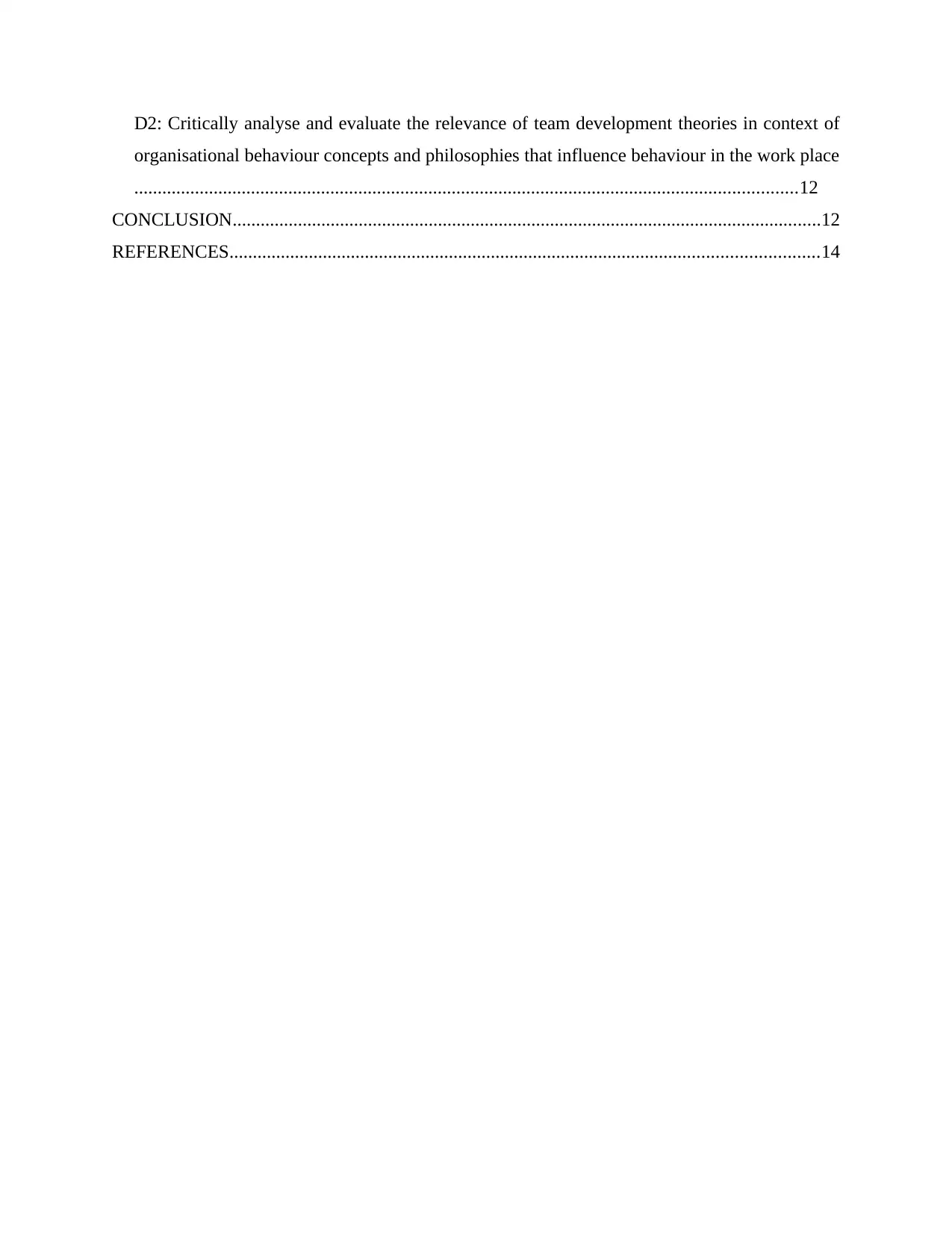
D2: Critically analyse and evaluate the relevance of team development theories in context of
organisational behaviour concepts and philosophies that influence behaviour in the work place
..............................................................................................................................................12
CONCLUSION..............................................................................................................................12
REFERENCES..............................................................................................................................14
organisational behaviour concepts and philosophies that influence behaviour in the work place
..............................................................................................................................................12
CONCLUSION..............................................................................................................................12
REFERENCES..............................................................................................................................14
⊘ This is a preview!⊘
Do you want full access?
Subscribe today to unlock all pages.

Trusted by 1+ million students worldwide
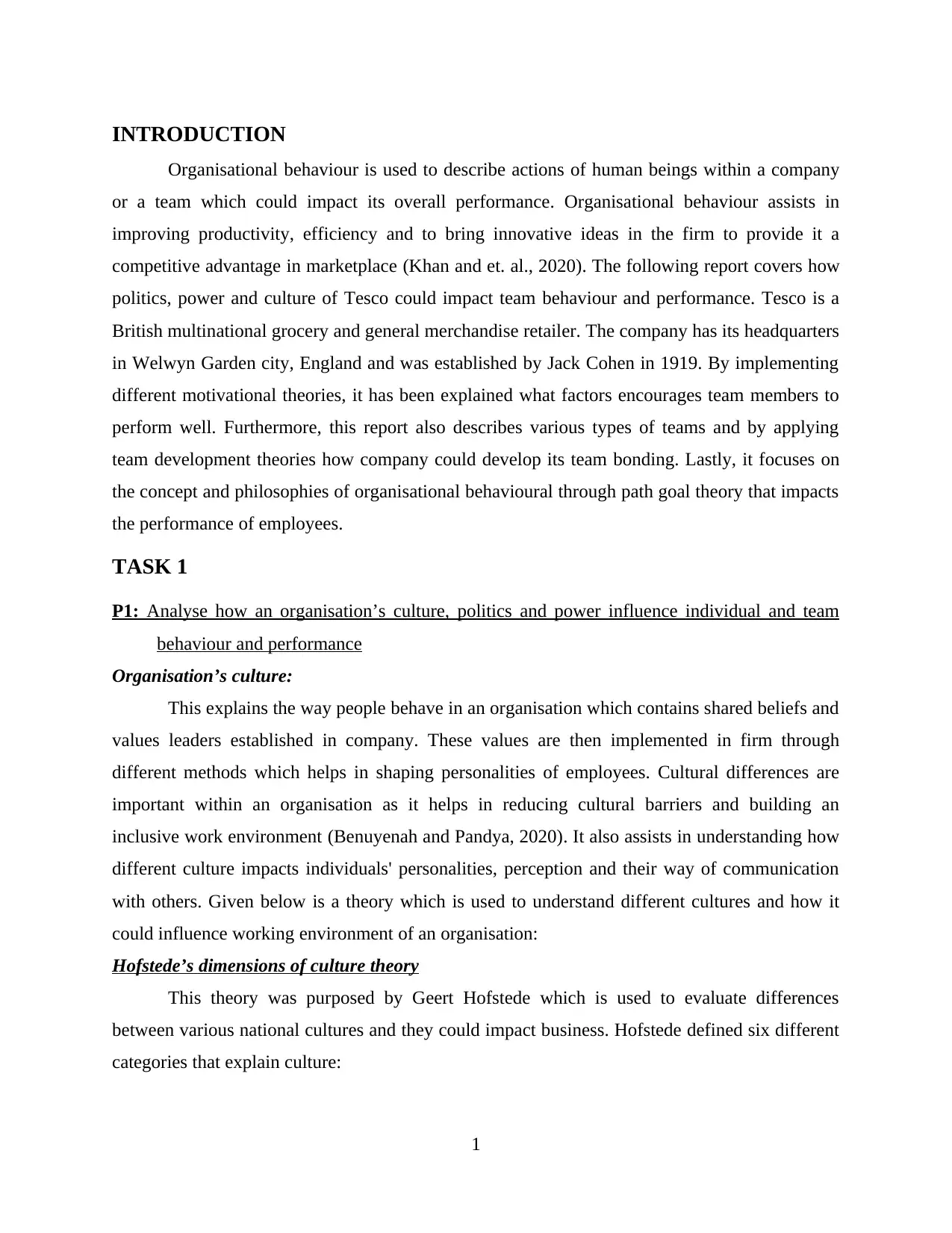
INTRODUCTION
Organisational behaviour is used to describe actions of human beings within a company
or a team which could impact its overall performance. Organisational behaviour assists in
improving productivity, efficiency and to bring innovative ideas in the firm to provide it a
competitive advantage in marketplace (Khan and et. al., 2020). The following report covers how
politics, power and culture of Tesco could impact team behaviour and performance. Tesco is a
British multinational grocery and general merchandise retailer. The company has its headquarters
in Welwyn Garden city, England and was established by Jack Cohen in 1919. By implementing
different motivational theories, it has been explained what factors encourages team members to
perform well. Furthermore, this report also describes various types of teams and by applying
team development theories how company could develop its team bonding. Lastly, it focuses on
the concept and philosophies of organisational behavioural through path goal theory that impacts
the performance of employees.
TASK 1
P1: Analyse how an organisation’s culture, politics and power influence individual and team
behaviour and performance
Organisation’s culture:
This explains the way people behave in an organisation which contains shared beliefs and
values leaders established in company. These values are then implemented in firm through
different methods which helps in shaping personalities of employees. Cultural differences are
important within an organisation as it helps in reducing cultural barriers and building an
inclusive work environment (Benuyenah and Pandya, 2020). It also assists in understanding how
different culture impacts individuals' personalities, perception and their way of communication
with others. Given below is a theory which is used to understand different cultures and how it
could influence working environment of an organisation:
Hofstede’s dimensions of culture theory
This theory was purposed by Geert Hofstede which is used to evaluate differences
between various national cultures and they could impact business. Hofstede defined six different
categories that explain culture:
1
Organisational behaviour is used to describe actions of human beings within a company
or a team which could impact its overall performance. Organisational behaviour assists in
improving productivity, efficiency and to bring innovative ideas in the firm to provide it a
competitive advantage in marketplace (Khan and et. al., 2020). The following report covers how
politics, power and culture of Tesco could impact team behaviour and performance. Tesco is a
British multinational grocery and general merchandise retailer. The company has its headquarters
in Welwyn Garden city, England and was established by Jack Cohen in 1919. By implementing
different motivational theories, it has been explained what factors encourages team members to
perform well. Furthermore, this report also describes various types of teams and by applying
team development theories how company could develop its team bonding. Lastly, it focuses on
the concept and philosophies of organisational behavioural through path goal theory that impacts
the performance of employees.
TASK 1
P1: Analyse how an organisation’s culture, politics and power influence individual and team
behaviour and performance
Organisation’s culture:
This explains the way people behave in an organisation which contains shared beliefs and
values leaders established in company. These values are then implemented in firm through
different methods which helps in shaping personalities of employees. Cultural differences are
important within an organisation as it helps in reducing cultural barriers and building an
inclusive work environment (Benuyenah and Pandya, 2020). It also assists in understanding how
different culture impacts individuals' personalities, perception and their way of communication
with others. Given below is a theory which is used to understand different cultures and how it
could influence working environment of an organisation:
Hofstede’s dimensions of culture theory
This theory was purposed by Geert Hofstede which is used to evaluate differences
between various national cultures and they could impact business. Hofstede defined six different
categories that explain culture:
1
Paraphrase This Document
Need a fresh take? Get an instant paraphrase of this document with our AI Paraphraser
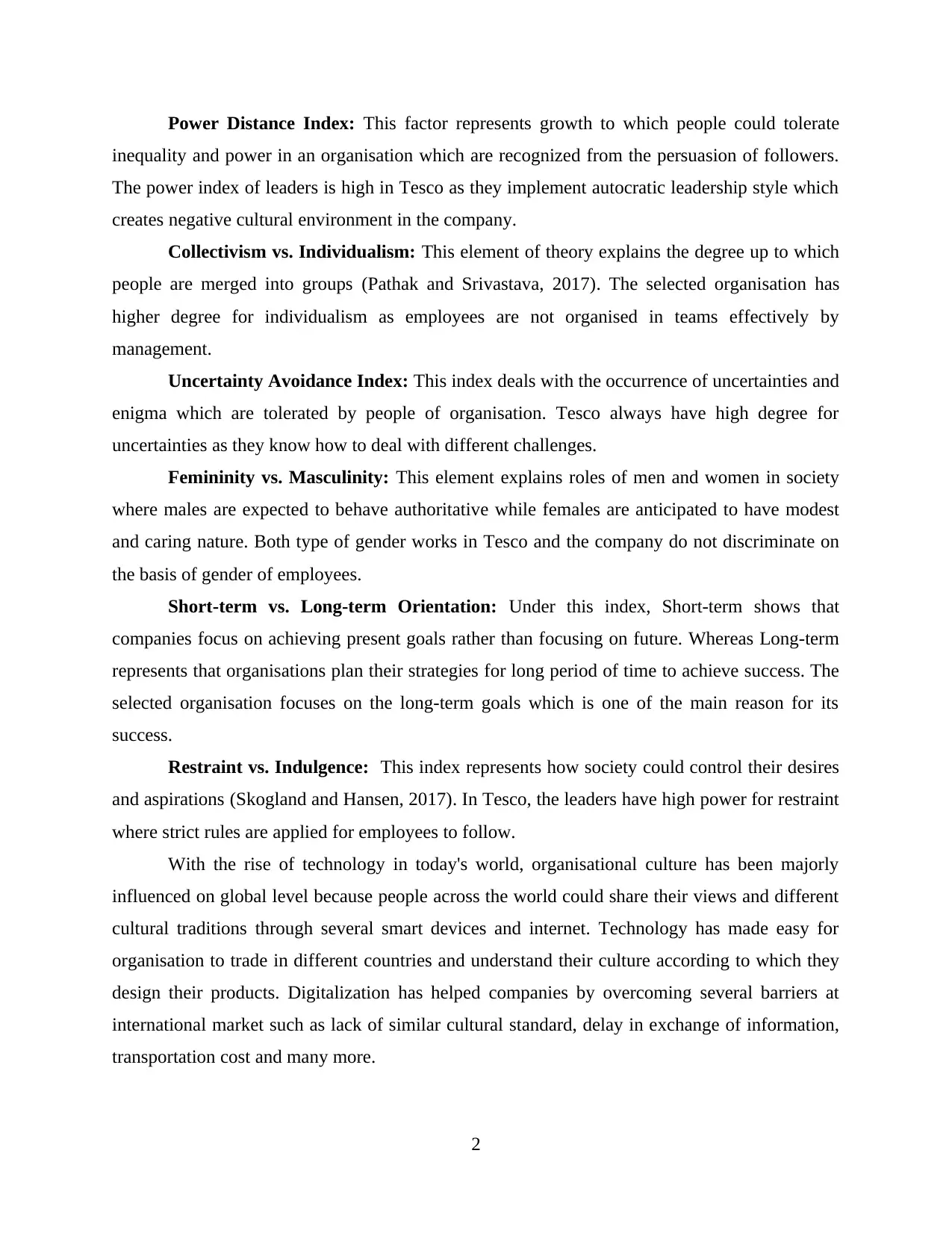
Power Distance Index: This factor represents growth to which people could tolerate
inequality and power in an organisation which are recognized from the persuasion of followers.
The power index of leaders is high in Tesco as they implement autocratic leadership style which
creates negative cultural environment in the company.
Collectivism vs. Individualism: This element of theory explains the degree up to which
people are merged into groups (Pathak and Srivastava, 2017). The selected organisation has
higher degree for individualism as employees are not organised in teams effectively by
management.
Uncertainty Avoidance Index: This index deals with the occurrence of uncertainties and
enigma which are tolerated by people of organisation. Tesco always have high degree for
uncertainties as they know how to deal with different challenges.
Femininity vs. Masculinity: This element explains roles of men and women in society
where males are expected to behave authoritative while females are anticipated to have modest
and caring nature. Both type of gender works in Tesco and the company do not discriminate on
the basis of gender of employees.
Short-term vs. Long-term Orientation: Under this index, Short-term shows that
companies focus on achieving present goals rather than focusing on future. Whereas Long-term
represents that organisations plan their strategies for long period of time to achieve success. The
selected organisation focuses on the long-term goals which is one of the main reason for its
success.
Restraint vs. Indulgence: This index represents how society could control their desires
and aspirations (Skogland and Hansen, 2017). In Tesco, the leaders have high power for restraint
where strict rules are applied for employees to follow.
With the rise of technology in today's world, organisational culture has been majorly
influenced on global level because people across the world could share their views and different
cultural traditions through several smart devices and internet. Technology has made easy for
organisation to trade in different countries and understand their culture according to which they
design their products. Digitalization has helped companies by overcoming several barriers at
international market such as lack of similar cultural standard, delay in exchange of information,
transportation cost and many more.
2
inequality and power in an organisation which are recognized from the persuasion of followers.
The power index of leaders is high in Tesco as they implement autocratic leadership style which
creates negative cultural environment in the company.
Collectivism vs. Individualism: This element of theory explains the degree up to which
people are merged into groups (Pathak and Srivastava, 2017). The selected organisation has
higher degree for individualism as employees are not organised in teams effectively by
management.
Uncertainty Avoidance Index: This index deals with the occurrence of uncertainties and
enigma which are tolerated by people of organisation. Tesco always have high degree for
uncertainties as they know how to deal with different challenges.
Femininity vs. Masculinity: This element explains roles of men and women in society
where males are expected to behave authoritative while females are anticipated to have modest
and caring nature. Both type of gender works in Tesco and the company do not discriminate on
the basis of gender of employees.
Short-term vs. Long-term Orientation: Under this index, Short-term shows that
companies focus on achieving present goals rather than focusing on future. Whereas Long-term
represents that organisations plan their strategies for long period of time to achieve success. The
selected organisation focuses on the long-term goals which is one of the main reason for its
success.
Restraint vs. Indulgence: This index represents how society could control their desires
and aspirations (Skogland and Hansen, 2017). In Tesco, the leaders have high power for restraint
where strict rules are applied for employees to follow.
With the rise of technology in today's world, organisational culture has been majorly
influenced on global level because people across the world could share their views and different
cultural traditions through several smart devices and internet. Technology has made easy for
organisation to trade in different countries and understand their culture according to which they
design their products. Digitalization has helped companies by overcoming several barriers at
international market such as lack of similar cultural standard, delay in exchange of information,
transportation cost and many more.
2
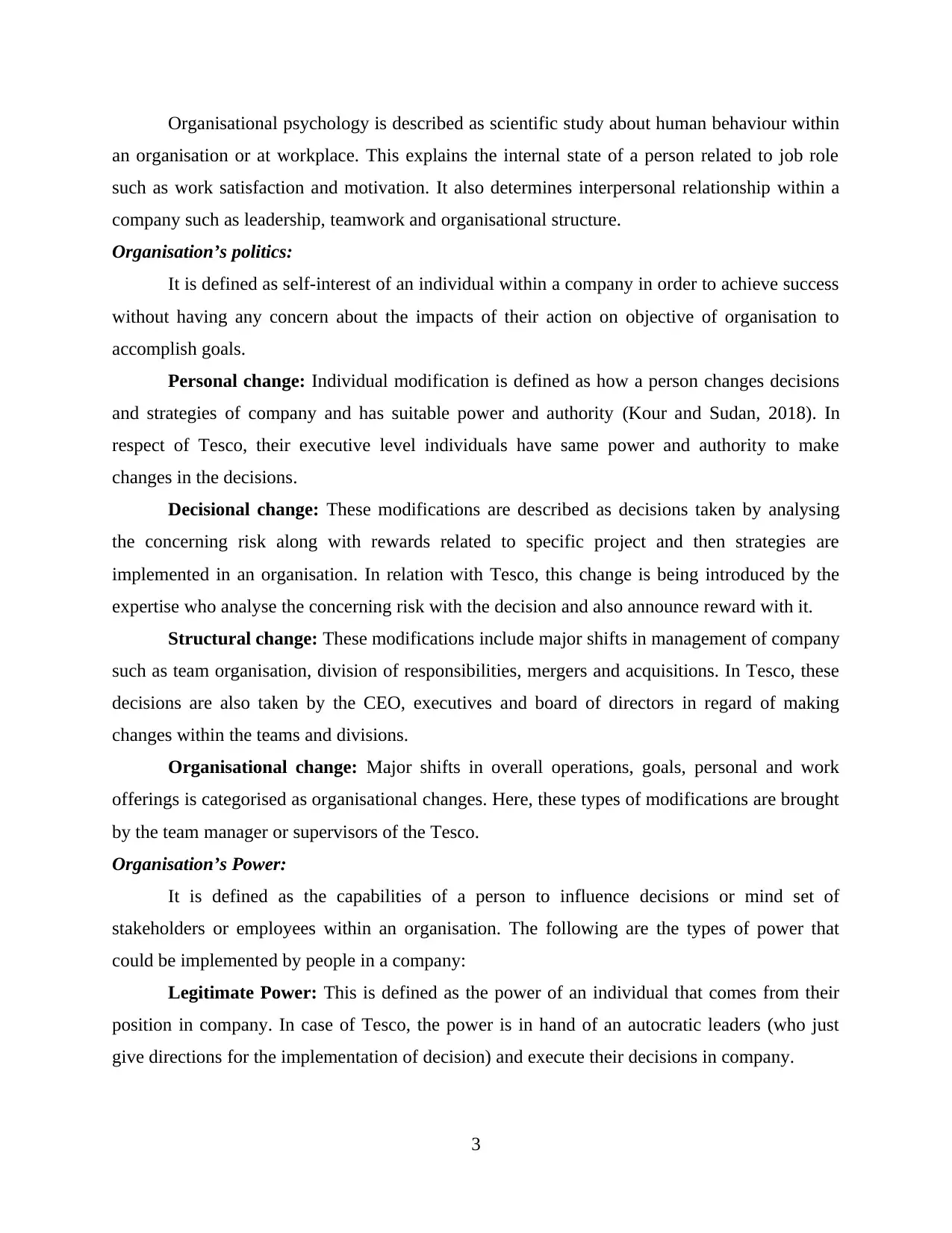
Organisational psychology is described as scientific study about human behaviour within
an organisation or at workplace. This explains the internal state of a person related to job role
such as work satisfaction and motivation. It also determines interpersonal relationship within a
company such as leadership, teamwork and organisational structure.
Organisation’s politics:
It is defined as self-interest of an individual within a company in order to achieve success
without having any concern about the impacts of their action on objective of organisation to
accomplish goals.
Personal change: Individual modification is defined as how a person changes decisions
and strategies of company and has suitable power and authority (Kour and Sudan, 2018). In
respect of Tesco, their executive level individuals have same power and authority to make
changes in the decisions.
Decisional change: These modifications are described as decisions taken by analysing
the concerning risk along with rewards related to specific project and then strategies are
implemented in an organisation. In relation with Tesco, this change is being introduced by the
expertise who analyse the concerning risk with the decision and also announce reward with it.
Structural change: These modifications include major shifts in management of company
such as team organisation, division of responsibilities, mergers and acquisitions. In Tesco, these
decisions are also taken by the CEO, executives and board of directors in regard of making
changes within the teams and divisions.
Organisational change: Major shifts in overall operations, goals, personal and work
offerings is categorised as organisational changes. Here, these types of modifications are brought
by the team manager or supervisors of the Tesco.
Organisation’s Power:
It is defined as the capabilities of a person to influence decisions or mind set of
stakeholders or employees within an organisation. The following are the types of power that
could be implemented by people in a company:
Legitimate Power: This is defined as the power of an individual that comes from their
position in company. In case of Tesco, the power is in hand of an autocratic leaders (who just
give directions for the implementation of decision) and execute their decisions in company.
3
an organisation or at workplace. This explains the internal state of a person related to job role
such as work satisfaction and motivation. It also determines interpersonal relationship within a
company such as leadership, teamwork and organisational structure.
Organisation’s politics:
It is defined as self-interest of an individual within a company in order to achieve success
without having any concern about the impacts of their action on objective of organisation to
accomplish goals.
Personal change: Individual modification is defined as how a person changes decisions
and strategies of company and has suitable power and authority (Kour and Sudan, 2018). In
respect of Tesco, their executive level individuals have same power and authority to make
changes in the decisions.
Decisional change: These modifications are described as decisions taken by analysing
the concerning risk along with rewards related to specific project and then strategies are
implemented in an organisation. In relation with Tesco, this change is being introduced by the
expertise who analyse the concerning risk with the decision and also announce reward with it.
Structural change: These modifications include major shifts in management of company
such as team organisation, division of responsibilities, mergers and acquisitions. In Tesco, these
decisions are also taken by the CEO, executives and board of directors in regard of making
changes within the teams and divisions.
Organisational change: Major shifts in overall operations, goals, personal and work
offerings is categorised as organisational changes. Here, these types of modifications are brought
by the team manager or supervisors of the Tesco.
Organisation’s Power:
It is defined as the capabilities of a person to influence decisions or mind set of
stakeholders or employees within an organisation. The following are the types of power that
could be implemented by people in a company:
Legitimate Power: This is defined as the power of an individual that comes from their
position in company. In case of Tesco, the power is in hand of an autocratic leaders (who just
give directions for the implementation of decision) and execute their decisions in company.
3
⊘ This is a preview!⊘
Do you want full access?
Subscribe today to unlock all pages.

Trusted by 1+ million students worldwide
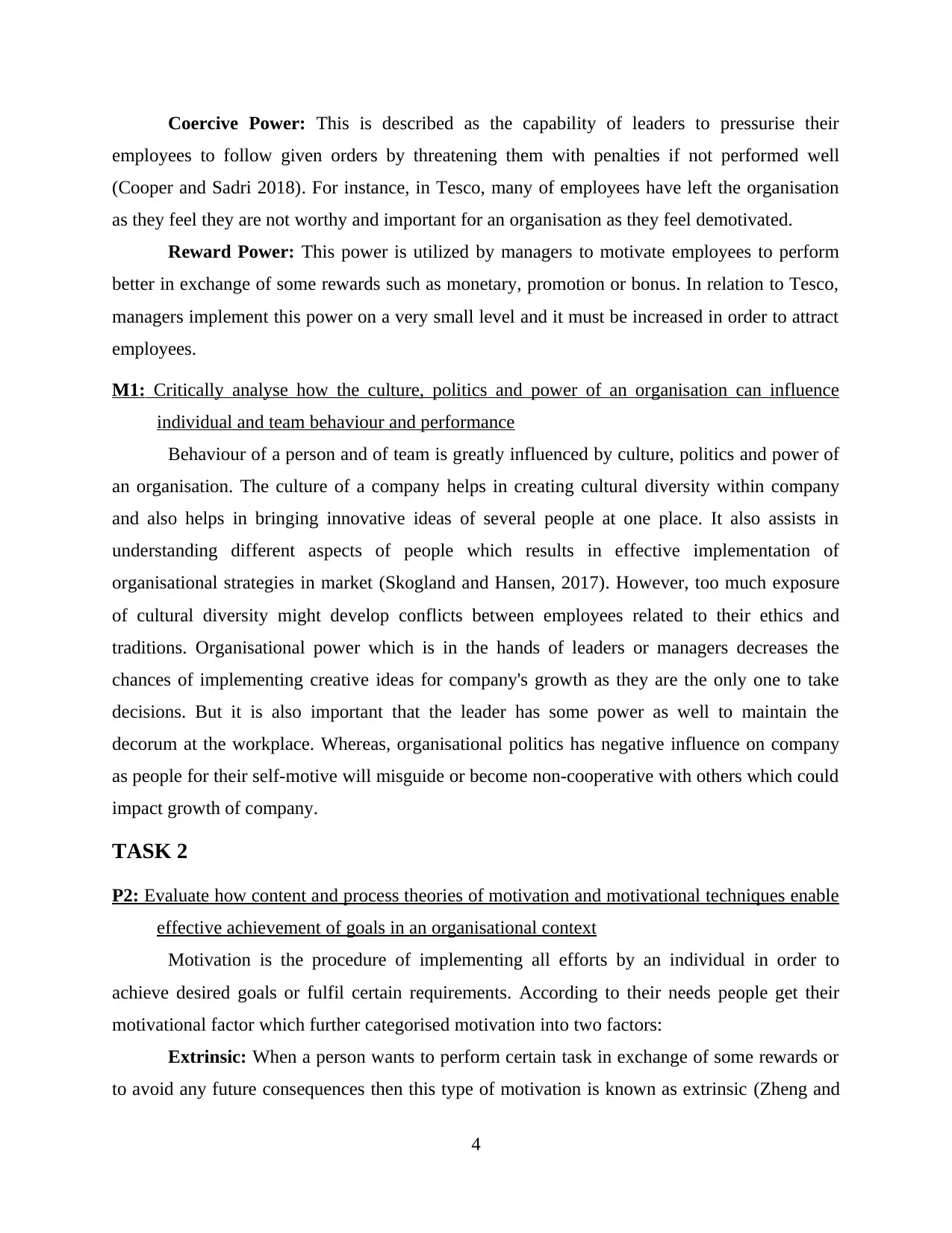
Coercive Power: This is described as the capability of leaders to pressurise their
employees to follow given orders by threatening them with penalties if not performed well
(Cooper and Sadri 2018). For instance, in Tesco, many of employees have left the organisation
as they feel they are not worthy and important for an organisation as they feel demotivated.
Reward Power: This power is utilized by managers to motivate employees to perform
better in exchange of some rewards such as monetary, promotion or bonus. In relation to Tesco,
managers implement this power on a very small level and it must be increased in order to attract
employees.
M1: Critically analyse how the culture, politics and power of an organisation can influence
individual and team behaviour and performance
Behaviour of a person and of team is greatly influenced by culture, politics and power of
an organisation. The culture of a company helps in creating cultural diversity within company
and also helps in bringing innovative ideas of several people at one place. It also assists in
understanding different aspects of people which results in effective implementation of
organisational strategies in market (Skogland and Hansen, 2017). However, too much exposure
of cultural diversity might develop conflicts between employees related to their ethics and
traditions. Organisational power which is in the hands of leaders or managers decreases the
chances of implementing creative ideas for company's growth as they are the only one to take
decisions. But it is also important that the leader has some power as well to maintain the
decorum at the workplace. Whereas, organisational politics has negative influence on company
as people for their self-motive will misguide or become non-cooperative with others which could
impact growth of company.
TASK 2
P2: Evaluate how content and process theories of motivation and motivational techniques enable
effective achievement of goals in an organisational context
Motivation is the procedure of implementing all efforts by an individual in order to
achieve desired goals or fulfil certain requirements. According to their needs people get their
motivational factor which further categorised motivation into two factors:
Extrinsic: When a person wants to perform certain task in exchange of some rewards or
to avoid any future consequences then this type of motivation is known as extrinsic (Zheng and
4
employees to follow given orders by threatening them with penalties if not performed well
(Cooper and Sadri 2018). For instance, in Tesco, many of employees have left the organisation
as they feel they are not worthy and important for an organisation as they feel demotivated.
Reward Power: This power is utilized by managers to motivate employees to perform
better in exchange of some rewards such as monetary, promotion or bonus. In relation to Tesco,
managers implement this power on a very small level and it must be increased in order to attract
employees.
M1: Critically analyse how the culture, politics and power of an organisation can influence
individual and team behaviour and performance
Behaviour of a person and of team is greatly influenced by culture, politics and power of
an organisation. The culture of a company helps in creating cultural diversity within company
and also helps in bringing innovative ideas of several people at one place. It also assists in
understanding different aspects of people which results in effective implementation of
organisational strategies in market (Skogland and Hansen, 2017). However, too much exposure
of cultural diversity might develop conflicts between employees related to their ethics and
traditions. Organisational power which is in the hands of leaders or managers decreases the
chances of implementing creative ideas for company's growth as they are the only one to take
decisions. But it is also important that the leader has some power as well to maintain the
decorum at the workplace. Whereas, organisational politics has negative influence on company
as people for their self-motive will misguide or become non-cooperative with others which could
impact growth of company.
TASK 2
P2: Evaluate how content and process theories of motivation and motivational techniques enable
effective achievement of goals in an organisational context
Motivation is the procedure of implementing all efforts by an individual in order to
achieve desired goals or fulfil certain requirements. According to their needs people get their
motivational factor which further categorised motivation into two factors:
Extrinsic: When a person wants to perform certain task in exchange of some rewards or
to avoid any future consequences then this type of motivation is known as extrinsic (Zheng and
4
Paraphrase This Document
Need a fresh take? Get an instant paraphrase of this document with our AI Paraphraser
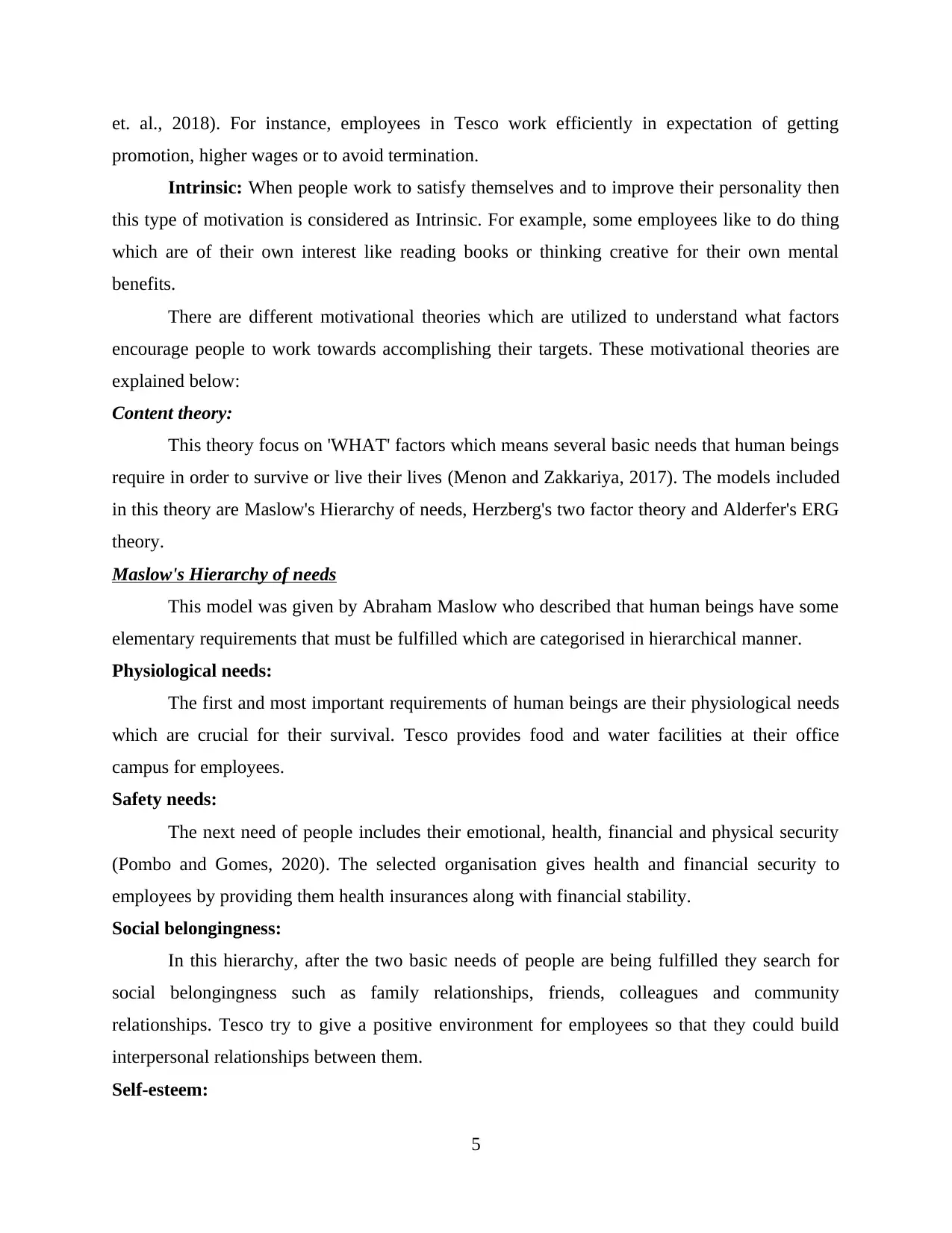
et. al., 2018). For instance, employees in Tesco work efficiently in expectation of getting
promotion, higher wages or to avoid termination.
Intrinsic: When people work to satisfy themselves and to improve their personality then
this type of motivation is considered as Intrinsic. For example, some employees like to do thing
which are of their own interest like reading books or thinking creative for their own mental
benefits.
There are different motivational theories which are utilized to understand what factors
encourage people to work towards accomplishing their targets. These motivational theories are
explained below:
Content theory:
This theory focus on 'WHAT' factors which means several basic needs that human beings
require in order to survive or live their lives (Menon and Zakkariya, 2017). The models included
in this theory are Maslow's Hierarchy of needs, Herzberg's two factor theory and Alderfer's ERG
theory.
Maslow's Hierarchy of needs
This model was given by Abraham Maslow who described that human beings have some
elementary requirements that must be fulfilled which are categorised in hierarchical manner.
Physiological needs:
The first and most important requirements of human beings are their physiological needs
which are crucial for their survival. Tesco provides food and water facilities at their office
campus for employees.
Safety needs:
The next need of people includes their emotional, health, financial and physical security
(Pombo and Gomes, 2020). The selected organisation gives health and financial security to
employees by providing them health insurances along with financial stability.
Social belongingness:
In this hierarchy, after the two basic needs of people are being fulfilled they search for
social belongingness such as family relationships, friends, colleagues and community
relationships. Tesco try to give a positive environment for employees so that they could build
interpersonal relationships between them.
Self-esteem:
5
promotion, higher wages or to avoid termination.
Intrinsic: When people work to satisfy themselves and to improve their personality then
this type of motivation is considered as Intrinsic. For example, some employees like to do thing
which are of their own interest like reading books or thinking creative for their own mental
benefits.
There are different motivational theories which are utilized to understand what factors
encourage people to work towards accomplishing their targets. These motivational theories are
explained below:
Content theory:
This theory focus on 'WHAT' factors which means several basic needs that human beings
require in order to survive or live their lives (Menon and Zakkariya, 2017). The models included
in this theory are Maslow's Hierarchy of needs, Herzberg's two factor theory and Alderfer's ERG
theory.
Maslow's Hierarchy of needs
This model was given by Abraham Maslow who described that human beings have some
elementary requirements that must be fulfilled which are categorised in hierarchical manner.
Physiological needs:
The first and most important requirements of human beings are their physiological needs
which are crucial for their survival. Tesco provides food and water facilities at their office
campus for employees.
Safety needs:
The next need of people includes their emotional, health, financial and physical security
(Pombo and Gomes, 2020). The selected organisation gives health and financial security to
employees by providing them health insurances along with financial stability.
Social belongingness:
In this hierarchy, after the two basic needs of people are being fulfilled they search for
social belongingness such as family relationships, friends, colleagues and community
relationships. Tesco try to give a positive environment for employees so that they could build
interpersonal relationships between them.
Self-esteem:
5
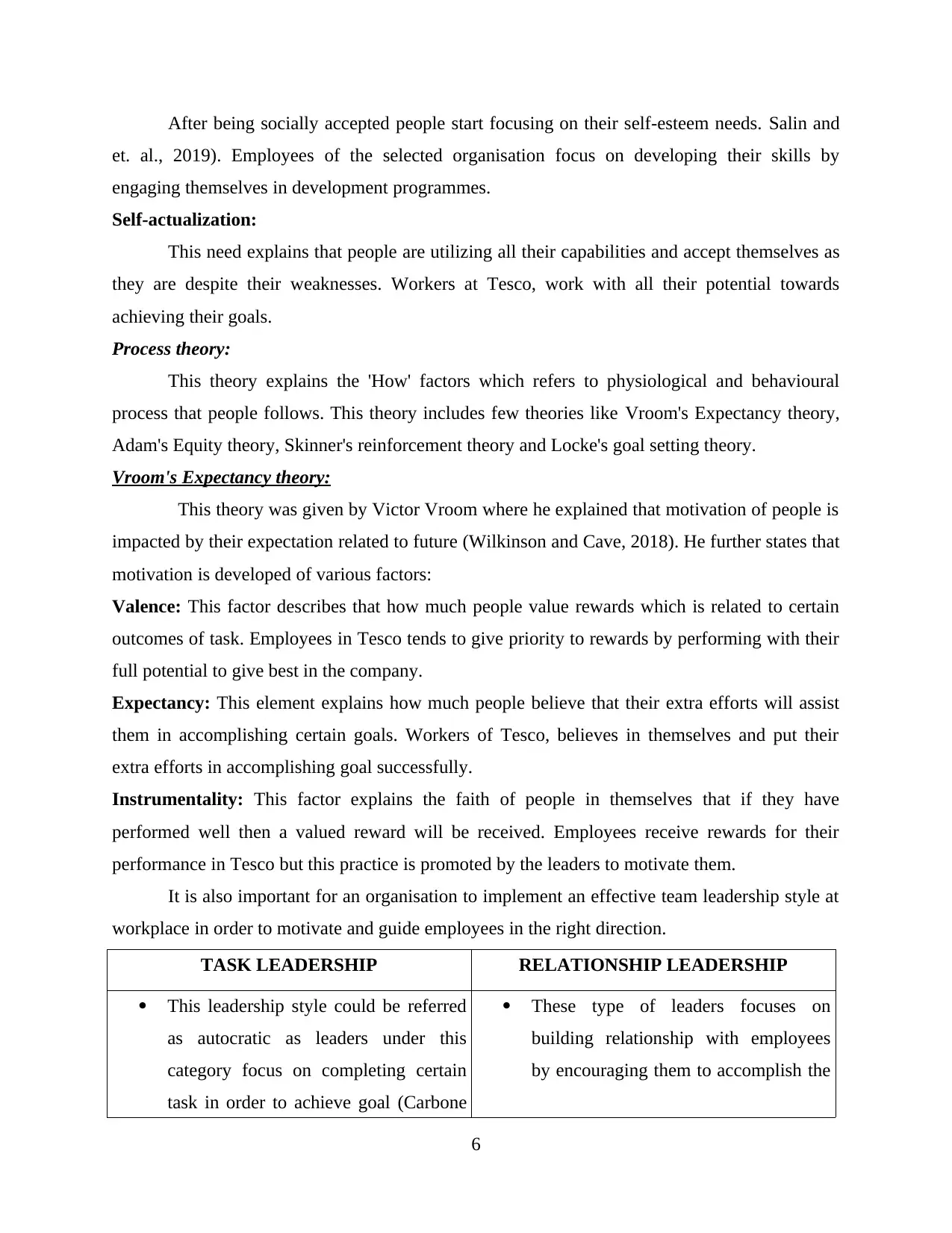
After being socially accepted people start focusing on their self-esteem needs. Salin and
et. al., 2019). Employees of the selected organisation focus on developing their skills by
engaging themselves in development programmes.
Self-actualization:
This need explains that people are utilizing all their capabilities and accept themselves as
they are despite their weaknesses. Workers at Tesco, work with all their potential towards
achieving their goals.
Process theory:
This theory explains the 'How' factors which refers to physiological and behavioural
process that people follows. This theory includes few theories like Vroom's Expectancy theory,
Adam's Equity theory, Skinner's reinforcement theory and Locke's goal setting theory.
Vroom's Expectancy theory:
This theory was given by Victor Vroom where he explained that motivation of people is
impacted by their expectation related to future (Wilkinson and Cave, 2018). He further states that
motivation is developed of various factors:
Valence: This factor describes that how much people value rewards which is related to certain
outcomes of task. Employees in Tesco tends to give priority to rewards by performing with their
full potential to give best in the company.
Expectancy: This element explains how much people believe that their extra efforts will assist
them in accomplishing certain goals. Workers of Tesco, believes in themselves and put their
extra efforts in accomplishing goal successfully.
Instrumentality: This factor explains the faith of people in themselves that if they have
performed well then a valued reward will be received. Employees receive rewards for their
performance in Tesco but this practice is promoted by the leaders to motivate them.
It is also important for an organisation to implement an effective team leadership style at
workplace in order to motivate and guide employees in the right direction.
TASK LEADERSHIP RELATIONSHIP LEADERSHIP
This leadership style could be referred
as autocratic as leaders under this
category focus on completing certain
task in order to achieve goal (Carbone
These type of leaders focuses on
building relationship with employees
by encouraging them to accomplish the
6
et. al., 2019). Employees of the selected organisation focus on developing their skills by
engaging themselves in development programmes.
Self-actualization:
This need explains that people are utilizing all their capabilities and accept themselves as
they are despite their weaknesses. Workers at Tesco, work with all their potential towards
achieving their goals.
Process theory:
This theory explains the 'How' factors which refers to physiological and behavioural
process that people follows. This theory includes few theories like Vroom's Expectancy theory,
Adam's Equity theory, Skinner's reinforcement theory and Locke's goal setting theory.
Vroom's Expectancy theory:
This theory was given by Victor Vroom where he explained that motivation of people is
impacted by their expectation related to future (Wilkinson and Cave, 2018). He further states that
motivation is developed of various factors:
Valence: This factor describes that how much people value rewards which is related to certain
outcomes of task. Employees in Tesco tends to give priority to rewards by performing with their
full potential to give best in the company.
Expectancy: This element explains how much people believe that their extra efforts will assist
them in accomplishing certain goals. Workers of Tesco, believes in themselves and put their
extra efforts in accomplishing goal successfully.
Instrumentality: This factor explains the faith of people in themselves that if they have
performed well then a valued reward will be received. Employees receive rewards for their
performance in Tesco but this practice is promoted by the leaders to motivate them.
It is also important for an organisation to implement an effective team leadership style at
workplace in order to motivate and guide employees in the right direction.
TASK LEADERSHIP RELATIONSHIP LEADERSHIP
This leadership style could be referred
as autocratic as leaders under this
category focus on completing certain
task in order to achieve goal (Carbone
These type of leaders focuses on
building relationship with employees
by encouraging them to accomplish the
6
⊘ This is a preview!⊘
Do you want full access?
Subscribe today to unlock all pages.

Trusted by 1+ million students worldwide
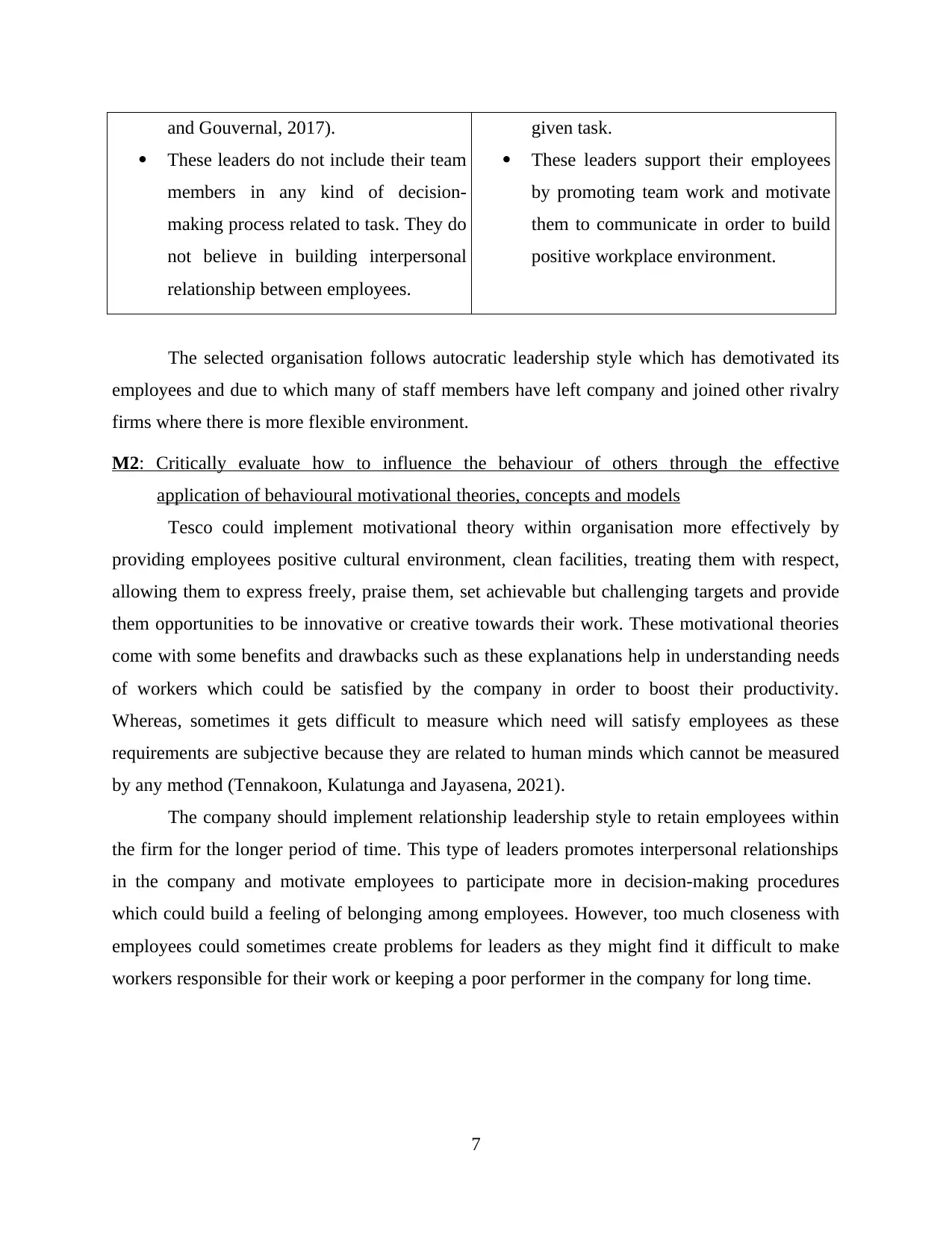
and Gouvernal, 2017).
These leaders do not include their team
members in any kind of decision-
making process related to task. They do
not believe in building interpersonal
relationship between employees.
given task.
These leaders support their employees
by promoting team work and motivate
them to communicate in order to build
positive workplace environment.
The selected organisation follows autocratic leadership style which has demotivated its
employees and due to which many of staff members have left company and joined other rivalry
firms where there is more flexible environment.
M2: Critically evaluate how to influence the behaviour of others through the effective
application of behavioural motivational theories, concepts and models
Tesco could implement motivational theory within organisation more effectively by
providing employees positive cultural environment, clean facilities, treating them with respect,
allowing them to express freely, praise them, set achievable but challenging targets and provide
them opportunities to be innovative or creative towards their work. These motivational theories
come with some benefits and drawbacks such as these explanations help in understanding needs
of workers which could be satisfied by the company in order to boost their productivity.
Whereas, sometimes it gets difficult to measure which need will satisfy employees as these
requirements are subjective because they are related to human minds which cannot be measured
by any method (Tennakoon, Kulatunga and Jayasena, 2021).
The company should implement relationship leadership style to retain employees within
the firm for the longer period of time. This type of leaders promotes interpersonal relationships
in the company and motivate employees to participate more in decision-making procedures
which could build a feeling of belonging among employees. However, too much closeness with
employees could sometimes create problems for leaders as they might find it difficult to make
workers responsible for their work or keeping a poor performer in the company for long time.
7
These leaders do not include their team
members in any kind of decision-
making process related to task. They do
not believe in building interpersonal
relationship between employees.
given task.
These leaders support their employees
by promoting team work and motivate
them to communicate in order to build
positive workplace environment.
The selected organisation follows autocratic leadership style which has demotivated its
employees and due to which many of staff members have left company and joined other rivalry
firms where there is more flexible environment.
M2: Critically evaluate how to influence the behaviour of others through the effective
application of behavioural motivational theories, concepts and models
Tesco could implement motivational theory within organisation more effectively by
providing employees positive cultural environment, clean facilities, treating them with respect,
allowing them to express freely, praise them, set achievable but challenging targets and provide
them opportunities to be innovative or creative towards their work. These motivational theories
come with some benefits and drawbacks such as these explanations help in understanding needs
of workers which could be satisfied by the company in order to boost their productivity.
Whereas, sometimes it gets difficult to measure which need will satisfy employees as these
requirements are subjective because they are related to human minds which cannot be measured
by any method (Tennakoon, Kulatunga and Jayasena, 2021).
The company should implement relationship leadership style to retain employees within
the firm for the longer period of time. This type of leaders promotes interpersonal relationships
in the company and motivate employees to participate more in decision-making procedures
which could build a feeling of belonging among employees. However, too much closeness with
employees could sometimes create problems for leaders as they might find it difficult to make
workers responsible for their work or keeping a poor performer in the company for long time.
7
Paraphrase This Document
Need a fresh take? Get an instant paraphrase of this document with our AI Paraphraser
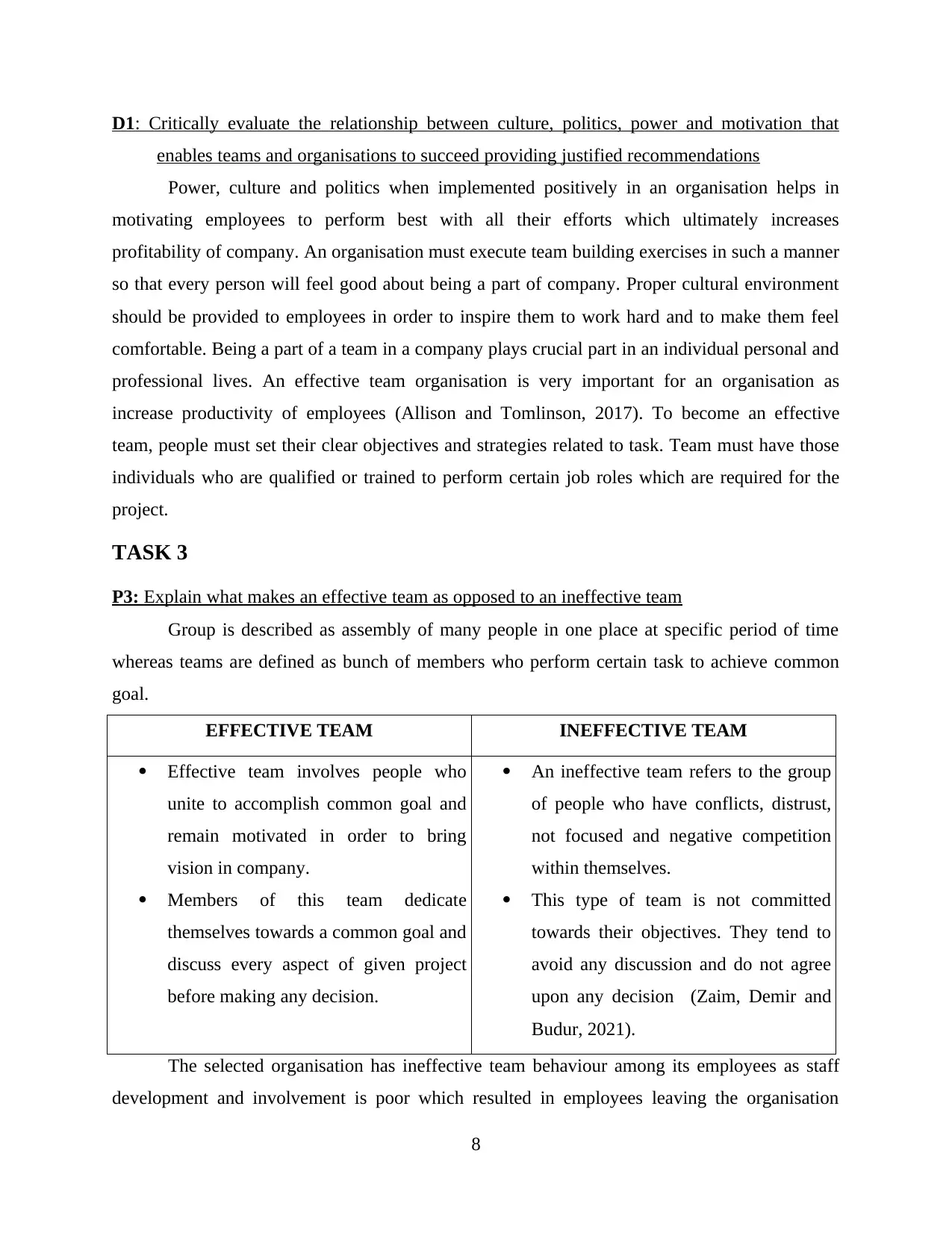
D1: Critically evaluate the relationship between culture, politics, power and motivation that
enables teams and organisations to succeed providing justified recommendations
Power, culture and politics when implemented positively in an organisation helps in
motivating employees to perform best with all their efforts which ultimately increases
profitability of company. An organisation must execute team building exercises in such a manner
so that every person will feel good about being a part of company. Proper cultural environment
should be provided to employees in order to inspire them to work hard and to make them feel
comfortable. Being a part of a team in a company plays crucial part in an individual personal and
professional lives. An effective team organisation is very important for an organisation as
increase productivity of employees (Allison and Tomlinson, 2017). To become an effective
team, people must set their clear objectives and strategies related to task. Team must have those
individuals who are qualified or trained to perform certain job roles which are required for the
project.
TASK 3
P3: Explain what makes an effective team as opposed to an ineffective team
Group is described as assembly of many people in one place at specific period of time
whereas teams are defined as bunch of members who perform certain task to achieve common
goal.
EFFECTIVE TEAM INEFFECTIVE TEAM
Effective team involves people who
unite to accomplish common goal and
remain motivated in order to bring
vision in company.
Members of this team dedicate
themselves towards a common goal and
discuss every aspect of given project
before making any decision.
An ineffective team refers to the group
of people who have conflicts, distrust,
not focused and negative competition
within themselves.
This type of team is not committed
towards their objectives. They tend to
avoid any discussion and do not agree
upon any decision (Zaim, Demir and
Budur, 2021).
The selected organisation has ineffective team behaviour among its employees as staff
development and involvement is poor which resulted in employees leaving the organisation
8
enables teams and organisations to succeed providing justified recommendations
Power, culture and politics when implemented positively in an organisation helps in
motivating employees to perform best with all their efforts which ultimately increases
profitability of company. An organisation must execute team building exercises in such a manner
so that every person will feel good about being a part of company. Proper cultural environment
should be provided to employees in order to inspire them to work hard and to make them feel
comfortable. Being a part of a team in a company plays crucial part in an individual personal and
professional lives. An effective team organisation is very important for an organisation as
increase productivity of employees (Allison and Tomlinson, 2017). To become an effective
team, people must set their clear objectives and strategies related to task. Team must have those
individuals who are qualified or trained to perform certain job roles which are required for the
project.
TASK 3
P3: Explain what makes an effective team as opposed to an ineffective team
Group is described as assembly of many people in one place at specific period of time
whereas teams are defined as bunch of members who perform certain task to achieve common
goal.
EFFECTIVE TEAM INEFFECTIVE TEAM
Effective team involves people who
unite to accomplish common goal and
remain motivated in order to bring
vision in company.
Members of this team dedicate
themselves towards a common goal and
discuss every aspect of given project
before making any decision.
An ineffective team refers to the group
of people who have conflicts, distrust,
not focused and negative competition
within themselves.
This type of team is not committed
towards their objectives. They tend to
avoid any discussion and do not agree
upon any decision (Zaim, Demir and
Budur, 2021).
The selected organisation has ineffective team behaviour among its employees as staff
development and involvement is poor which resulted in employees leaving the organisation
8
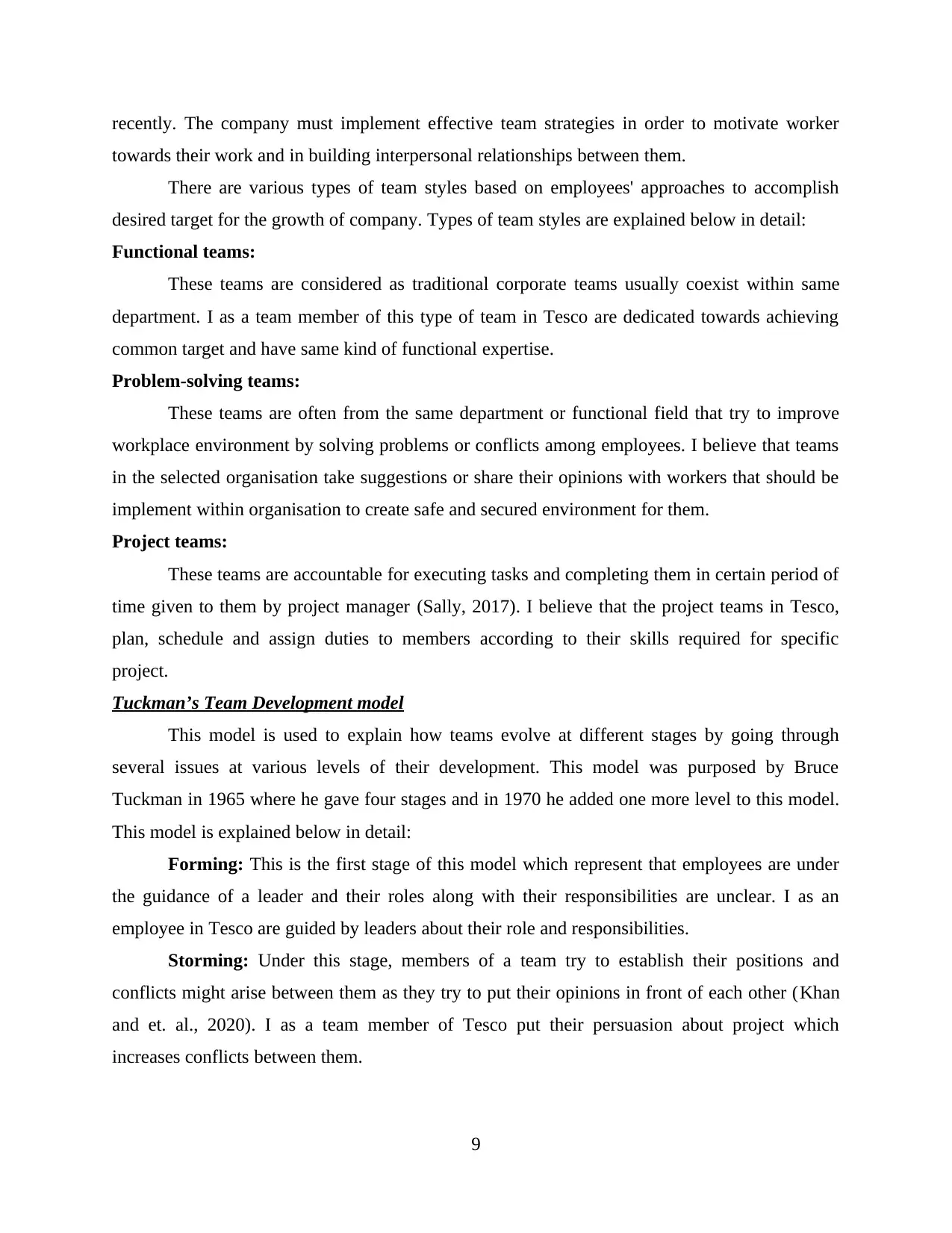
recently. The company must implement effective team strategies in order to motivate worker
towards their work and in building interpersonal relationships between them.
There are various types of team styles based on employees' approaches to accomplish
desired target for the growth of company. Types of team styles are explained below in detail:
Functional teams:
These teams are considered as traditional corporate teams usually coexist within same
department. I as a team member of this type of team in Tesco are dedicated towards achieving
common target and have same kind of functional expertise.
Problem-solving teams:
These teams are often from the same department or functional field that try to improve
workplace environment by solving problems or conflicts among employees. I believe that teams
in the selected organisation take suggestions or share their opinions with workers that should be
implement within organisation to create safe and secured environment for them.
Project teams:
These teams are accountable for executing tasks and completing them in certain period of
time given to them by project manager (Sally, 2017). I believe that the project teams in Tesco,
plan, schedule and assign duties to members according to their skills required for specific
project.
Tuckman’s Team Development model
This model is used to explain how teams evolve at different stages by going through
several issues at various levels of their development. This model was purposed by Bruce
Tuckman in 1965 where he gave four stages and in 1970 he added one more level to this model.
This model is explained below in detail:
Forming: This is the first stage of this model which represent that employees are under
the guidance of a leader and their roles along with their responsibilities are unclear. I as an
employee in Tesco are guided by leaders about their role and responsibilities.
Storming: Under this stage, members of a team try to establish their positions and
conflicts might arise between them as they try to put their opinions in front of each other (Khan
and et. al., 2020). I as a team member of Tesco put their persuasion about project which
increases conflicts between them.
9
towards their work and in building interpersonal relationships between them.
There are various types of team styles based on employees' approaches to accomplish
desired target for the growth of company. Types of team styles are explained below in detail:
Functional teams:
These teams are considered as traditional corporate teams usually coexist within same
department. I as a team member of this type of team in Tesco are dedicated towards achieving
common target and have same kind of functional expertise.
Problem-solving teams:
These teams are often from the same department or functional field that try to improve
workplace environment by solving problems or conflicts among employees. I believe that teams
in the selected organisation take suggestions or share their opinions with workers that should be
implement within organisation to create safe and secured environment for them.
Project teams:
These teams are accountable for executing tasks and completing them in certain period of
time given to them by project manager (Sally, 2017). I believe that the project teams in Tesco,
plan, schedule and assign duties to members according to their skills required for specific
project.
Tuckman’s Team Development model
This model is used to explain how teams evolve at different stages by going through
several issues at various levels of their development. This model was purposed by Bruce
Tuckman in 1965 where he gave four stages and in 1970 he added one more level to this model.
This model is explained below in detail:
Forming: This is the first stage of this model which represent that employees are under
the guidance of a leader and their roles along with their responsibilities are unclear. I as an
employee in Tesco are guided by leaders about their role and responsibilities.
Storming: Under this stage, members of a team try to establish their positions and
conflicts might arise between them as they try to put their opinions in front of each other (Khan
and et. al., 2020). I as a team member of Tesco put their persuasion about project which
increases conflicts between them.
9
⊘ This is a preview!⊘
Do you want full access?
Subscribe today to unlock all pages.

Trusted by 1+ million students worldwide
1 out of 19
Related Documents
Your All-in-One AI-Powered Toolkit for Academic Success.
+13062052269
info@desklib.com
Available 24*7 on WhatsApp / Email
![[object Object]](/_next/static/media/star-bottom.7253800d.svg)
Unlock your academic potential
Copyright © 2020–2025 A2Z Services. All Rights Reserved. Developed and managed by ZUCOL.

